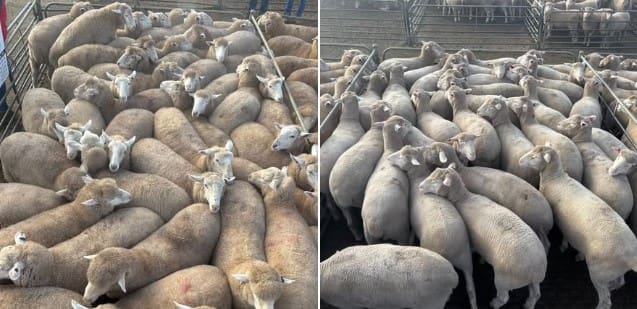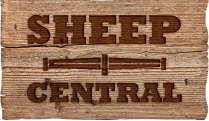
The Elders Mark Flagg agency’s top two pens of lambs at the Griffith sale today.
NEW South Wales sheep saleyards have concluded another record-breaking week with a new national heavy lamb record of $424.20 set at Wagga Wagga yesterday and then broken twice today at Griffith with $430 and $431 pens.
The high lamb prices are also lifting concerns that more maternal ewe lambs will be sent into saleyards to take advantage of the extreme rates, and that processors might soon wind back operations in response to lower supplies.
At the Griffith saleyards today, Elders Mark Flagg Griffith sold a pen of 33 Poll Dorset-Merino cross lambs estimated at 40kg cwt, from K.F. and J.L. Mannes of Coleambally. They sold to Southern Meats at Goulburn.
Agent Mark Flagg said the processor had earlier paid $430 for 47 Poll Dorset cross lambs about 80kg lwt from Alkoisi Ag, Beelbangera.
The Griffith prices exceeded the previous national record set at Wagga Wagga yesterday, when 131 lambs were sold for $425 and knocked down to $424.20 to Dubbo processor Fletcher International Exports.
Mr Flagg said the new record might stand for a while.
“It will be interesting to see if there any more big bangers out there or whether they bring it back back a bit or keep going like this.
“They were exceptional lambs and an exceptional sale; it didn’t matter what you had today the wind was blowing.”
Mr Flagg said the Mannes draft of about 350 30-40kg cwt lambs averaged around $405.
“It was as good as you want to see.”
Mr Flagg said he would like to see the lamb market a bit cheaper and more consistent.
Woolly lambs make $242.20 at Wagga
Wagga Selling Agents Association president Isaac Hill said the record-setting lambs were woolly and followed some 42kg Aussie White lambs offered by an AWN client that sold for $408.
“I think $400 was achieved about four times during the day.”
He said market was general $30 dearer right through and although the $424.20 lambs were woolly they achieved the record price as a result of processors rushing to fill trucks on the last run of heavy lambs in the sale offered by Elders. He said an Aussie White producer said he averaged $11.67/kg for 300 lambs.
Mr Hill said processors and supermarkets have had to lower their standards to get lamb supplies.
He said 70pc of the local flocks lamb down in March-April and there will be store new season lambs available in mid-July at around 15kg cwt.
“By August we start to see the super singles, so the first couple of weeks of August we will have lambs here at 23-24kg cwt.
“They won’t be very prevalent because it has been so dry, but there will always be the bloke that overfeeds and is happy to do so.”
Mr Hill said supermarkets are having to pay over $300 for 28kg lambs when they normally would be operating in a 24-26kg weight range.
“I scrolled back and in the first week of September in 2023 our sheep and lambs combined averaged $67 for the day, we averaged $216 today for sheep and lambs.
“It’s because of that $67 that we are averaging better than $200 today, because everyone bailed out.”
High prices flushing out ewe lambs
Elders Wagga agent Henry Booth said the $424.20 lambs were longer in the wool and had picked up a bit of mud from the wet weather in the feedlot. The 133 Poll Dorset cross lambs from Yarrawonga Pastoral at Gundagai were sold by auctioneer Adam Boyd. They had an estimated carcase weight of 37-39 kg and sold to Fletcher International Exports as processors competed to fill trucks, he said.
Click on this link to see the Elders livestream of the sale.
Mr Booth said the Yarrawonga Pastoral’s 285 seconds made $369 and the thirds made $345, with the overall average for more than 500 lambs being over $375.
He said the high prices are flushing out scanned in-lamb ewe lambs that would have been retained in a normal season and also sending in ewe hoggets because of the strong mutton prices. He said in some cases the ewe lambs coming into saleyards are from flocks with very bad scan results, with some composite flocks scanning 5-15pc in-lamb. There have also been plenty of scanned ewes from farms that have run out of feed and water being sent straight to abattoirs, he said.
RLA auctioneer at Wagga James Tierney said the RLA run for 12,000 sheep and lambs averaged $226 this week and he had noticed more ewe lambs and ewes being offered for sale, although not through RLA this week.
“It was something else today, I think it was as dear as anyone has seen it today.”
Mr Flagg said he was aware that ewe lambs were coming into saleyards in other areas, but at the Barellan first cross ewe sale in February this year close to 50pc of the ewes sold to meat buyers and at the 2024 sale about 35pc.
He could imagine breeders that normally present first cross ewes for sale as 1.5 year-olds selling for the current high prices.
“It was only a month ago you could have bought 1-1.5 year-old first cross scanned in lamb for $187, nobody wanted to touch them.
“It’s on the nose, store sheep and even here in our mixed farming district, I’ve had three lots of Merino ewes go straight to works and some consigned today, which made $300, had the March-April drop lambs taken straight off them, run out of water.”
He said heavy crossbred ewes and a big consignment of 4.5 year-old Merino ewes sold for $300 at Griffith today.
All major lamb indicators hit record territory
MLA senior market information analyst Erin Lukey said all major lamb indicators reached record highs this week.
In her weekly wrap, Ms Lukey said Lamb production remains seasonal with predictable fluctuations throughout the year in finished lamb availability.
“Supply is typically lowest in winter, driving prices up before easing with the new-season lamb arrivals in spring.
“Market movements in 2025 are underpinned by this seasonal dynamic,” she said.
Ms Lukey said national lamb prices are currently at record high levels.
“The National Light Lamb Indicator (924c/kg cwt), National Trade Lamb Indicator (1049c/kg cwt) and National Heavy Lamb Indicator (1041c/kg cwt) all surged as winter’s traditional supply tightens.
“Light lamb prices have particularly strengthened due to demand for available finished stock.”
Ms Luke said processor procurement has shifted with decreased supply.
“High availability allows for targeted purchasing by weight category, but current conditions are prompting a broader, volume-driven approach as processors seek to maintain throughput.
“Processing capacity has lifted to meet lamb supply over the past three years of flock rebuild,” she said.
“Average weekly slaughter in 2025 sits at 471,000 head according to National Livestock Reporting Service reporting.
“With seasonal supply constraints, some processors will soon enter their expected winter shutdown period.”
Ms Lukey said the national heavy and trade lamb indicators both exceeded 1000c/kg cwt for the first time together this week, reflecting sustained demand for finished lambs across domestic and export markets.
“The Trade Lamb Indicator (1049c/kg cwt) notably passed the Heavy Lamb Indicator (1041c/kg cwt), going against a three-year trend.
“While the United States, Australia’s largest lamb market, typically favours carcases exceeding 30kg cwt, the current shift may reflect tighter trade-weight supply, increased domestic demand and mid-weight export competition,” she said.
Ms Lukey said historically, price strength persists through winter until new-season lamb arrivals.
“With all three major indicators at record levels, ongoing processor activity and supply dynamics will be key to how the market evolves through the seasonal low-turnoff period.”

HAVE YOUR SAY